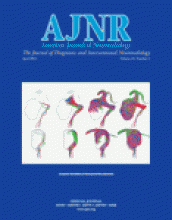The first day of residency, I was told that a radiologist looking for a ruler is a radiologist in trouble. During my fellowship in neuroradiology, we had a special ruler that was designed to identify shift of the pineal gland on the anteroposterior skull radiograph. The first-generation CT scanner made that ruler obsolete. We continue to train our residents and fellows in the tradition of training their eyes to identify and characterize abnormalities without the need for a ruler.
In this issue, Stafira et al found that qualitative evaluation of cervical spinal stenosis was subjective. Six neuroradiologists could not agree on the level, degree, or cause of cervical stenosis on CT or MR images in 38 patients. On the basis of these results, they recommend the implementation of semiquantitative measurement of the spinal canal on cross-sectional studies. Possible measurements discussed include a one-dimensional measurement similar to the formula used in the North American Symptomatic Carotid Endarterectomy Trial, a calculation of the ratio of the spinal canal to the vertebral body in the sagittal dimension (Torg-Pavlov ratio), or a calculation of the cross-sectional area from two measurements.
The results of this study are not particularly surprising. The difference between mild and moderate central canal stenosis and between moderate and severe central canal stenosis is blurred. Mild stenosis to one observer may be moderate to another. This is influenced by one’s experience. During our careers in radiology, we fluctuate from being “overcallers” to “undercallers” based on the accuracy of our last call. With experience, the amplitude of these fluctuations decreases. The term “stenosis” itself is confusing. Our surgeons understand stenosis to mean surgical disease with significant spinal cord compression. Everything else is spondylosis.
The statistical methodology that the authors used is the standard methodology that is usually used in this type of analysis, but it is not a perfect measure of agreement. The κ statistic sometimes looks bad even when most observers agree. My impression from their data is that the agreement is pretty good for the degree of stenosis, particularly since the six radiologists were from various backgrounds with various training.
Stafira et al are correct that consistency in reporting is the most important factor in evaluating the efficacy of imaging studies and ultimately patient care. More accurately measuring the cross-sectional area or diameter of the cervical canal is likely to be more consistent, but may have limited clinically utility. The status of the spinal cord is the most important factor that influences whether a patient may benefit from decompressive surgery or whether further clinical investigations are warranted to rule other causes of myelopathy. Houser et al (1) found a high correlation with the shape of the spinal cord and myelopathy on neurologic examination. Ninety-eight percent of patients with severe spinal cord compression, described as a “banana”-shaped cord, had myelopathy clinically, whereas the frequency of myelopathy decreased to 75% of patients with moderately severe cord compression and 71% of patients with moderate cord compression. A consistent and reproducible description of spinal cord compression may be more helpful than measuring the diameter, area, or ratio of the central spinal canal. Other contributing factors important in surgical decision making include cord signal intensity on T2-weighted images, cord caliber and shape (atrophy), involvement at multiple levels, and obstruction to the flow of contrast material in the subarachnoid space as seen at myelography. The eye can integrate multiple factors that cannot be described with a single measurement. Radiologic interpretation remains an art refined by years of experience.
Finally, the pathophysiology of myelopathy is complex. From data by Houser et al (1), 2% of patients with severe cord compression, 25% of patients with moderately severe spinal cord compression, and 29% of patients with moderate cord compression at imaging had no evidence of myelopathy clinically. Even with accurate and reproducible measurements, we must remember that our clinical colleagues are treating patients and not the images.
Reference
- Copyright © American Society of Neuroradiology











